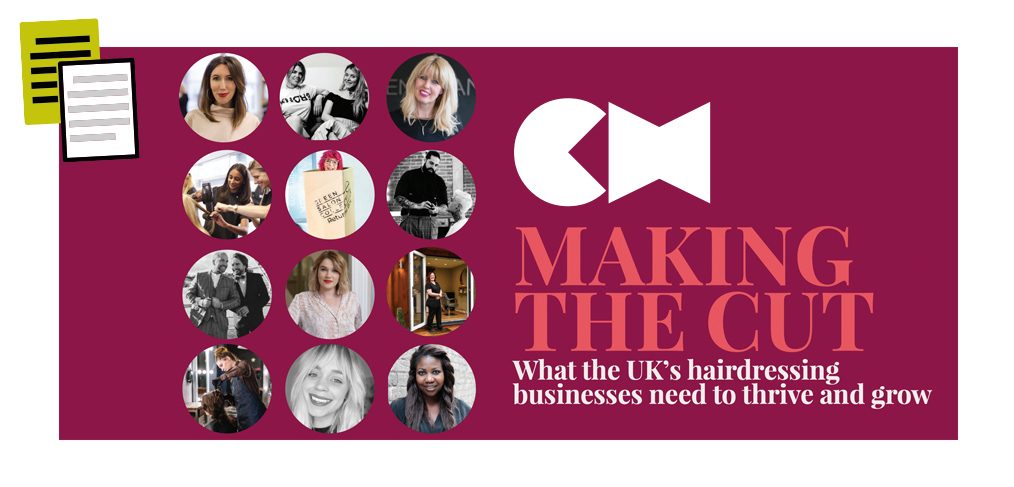
Making The Cut
A shortage of business skills, rising employment costs, a lack of new recruits and a stubborn refusal to embrace online booking are holding the industry back, a new report reveals. So what’s to be done?
UK hairdressing, a growing industry populated by ambitious entrepreneurs, is facing a series of challenges that could impact on future growth, a new report shows.
Making the Cut, produced by Creative HEAD in collaboration with the National Hair & Beauty Federation (NHBF), the Freelance Hairdressers Association, the British Beauty Council and The Hairdressing Industry CIC, asked 100 salon owners and 100 self-employed hairdressers about their plans to grow and what holds them back from realising their ambitions. It reveals how, even before Covid-19, a perfect storm of market saturation and rising Minimum Wage costs was devastating traditional salon employment models, leading to a clear trend among salon bosses towards freezing recruitment, reducing hours for existing staff and taking on self-employed chair renters instead of directly employing people. The traditional concept of hairdressing as a 9 to 5 job in a local salon with a single employer no longer constitutes the way a substantial proportion of the workforce makes a living – 60% of all hair professionals are now self-employed.
Those who continue to directly employ their own staff cite unfair competition, perceiving salon owners who have moved towards using self-employed workers as gaining an advantage by reducing their turnover below the VAT threshold without reducing profits or prices. Perhaps more worryingly for the industry in general, demand for apprenticeships has dropped by 30% since 2019*; salon owners say they can’t afford to pay for apprentices, and self-employed hairdressers simply don’t take on and train new staff. This inevitably means there will be a huge skills shortage over the coming years.
While a shortage of new recruits has impacted the sector over the last few years, it is clear that this has now become a major threat to growth: a lack of quality and diversity of talent, both now and anticipated in the future, was named as a key challenge by the salon owners we spoke to. It’s clear that perceptions about low pay and lack of opportunity have created a lack of desire to enter the profession – an early 2020 survey by industry giant L’Oréal Professionnel found that 51% of consumers think hairdressing is a low-skill career, and 75% were not told about hairdressing as a career option when they were at school. This is impacting on the industry – young people going into the profession fell by 13% in 2018/19, according to the NHBF.
Amongst hairdressing business owners themselves, there is an urgent need for more support on how to set up and/or run a business, including how to manage cashflow, tax, pensions and legal issues. Overwhelmingly, salon owners voiced a need for more management training to help them cope with the day-to-day running of their business, with many stating they felt out of their depth when it came to knowledge and skills related to employment law, HR and other management issues. More than one in three self-employed hairdressers (36%) identified a lack of business support and/or a lack of knowledge on where to find that support to grow as a key challenge to future growth.
Finally, the failure to digitise booking processes is threatening the profitability of the industry, with research showing that £1.2 billion is lost every year as clients fail to keep their pre-booked appointments. Only 3% of hair and beauty appointments are booked online – a reflection of how many salon owners stubbornly cling to their paper appointment books, largely through fear of change.
What follows here is a precis of key findings and recommendations within the report. A full version of Making The Cut can be found HERE
 KEY FINDING #1: WHAT DOES GROWTH LOOK LIKE FOR HAIRDRESSING BUSINESSES?
KEY FINDING #1: WHAT DOES GROWTH LOOK LIKE FOR HAIRDRESSING BUSINESSES?
Government has traditionally measured enterprise growth either by revenue turnover or by directly employed headcount. Turnover was an important measure of growth for many hairdressing businesses, but most also stressed that increased profile, reputation and client numbers were more vital benchmarks. For the majority of hairdressing businesses, headcount was not a primary measure of growth – a reflection of the sector’s increasingly freelance-heavy workforce.
The traditional concept of hairdressing as a 9 to 5 job in a local salon with a single employer no longer constitutes the way a substantial proportion of the workforce makes a living – 60 per cent of all hair professionals are now self-employed, keen to exert more control over their own time and destiny, and Covid-19 will grow that number still further.
Faced with rising employment costs, an increasing number of salon owners no longer directly employ their workers, instead engaging them as self-employed sub-contractors. However, disguised employment is a concern, and the fact that the HMRC has not actively enforced the law in terms of stamping this out has led to a false sense of security for many, who believe they can evade and avoid their tax obligations.
The trend to self-employment is impacting heavily on apprenticeships: despite having been improved better to serve employer requirements, hairdressing and barbering apprenticeships starts plummeted by 30% in 2019/20, compared to the previous year.
VAT-registered salons in the UK account for 12,300 businesses, employing 94,686 staff and generating a total of £3.35billion in turnover**

CASE STUDY: HOOKER & YOUNG, NORTH EAST
Gary Hooker and Michael Young are co-owners of Hooker & Young, a group of four luxury hair salons the North East of England. Established in 1996, today the group employs 47 staff and generates a turnover of around £2million.
Says Michael: “We are very much aware of the rise of the self-employed stylist and the impact it has had on the industry at large. We’ve thought for some time now that hairdressing is changing; it’s inevitable, really.
However, we are working on a new model which may allow other creatives from outside Hooker & Young to use our space collaboratively. It’s something that interests us, and it may well become the way people want to work creatively – having that self-employed independence whilst still being associated with a quality brand.
“We’ve had open forums with our entire team discussing the self-employed model and have only ever had a negative response – they really don’t see the plus sides to working that way. I guess it’s not for everyone, but if ‘rent-a-chair’ is all you’ve ever known then it’s just the normal way of working.”
42% of the salon owners we surveyed have at least one self-employed stylists in their business

CASE STUDY: TINT, LEEDS
Matthew Sutcliffe and Zak Whiteley set up Tint in Leeds in 2017, having worked together as fully employed stylists and then in an all self-employed salon.
Says Matthew: “When I left my employed role I worked at a salon which only had self-employed stylists. I loved the energy of that salon and that I earned more money but also had the flexibility to choose when I worked. Zak and I both discussed that self-employment was probably the future of hairdressing, but we knew it could be done better.”
Seeing a gap in the market Matt and Zak set Tint up to be a progressive new hybrid model – offering the education, training and opportunities traditionally associated with being employed full-time, but with the flexible and financial advantages of being self-employed. The stylists operate as a team, despite their individual independent status. And there are still full-time employees.
“The Tint model is a primarily rent-a-chair. We are constantly reviewing what we can offer stylists as part of their benefits package that will keep them here, rather than choosing another salon. I know there is an argument about VAT, but we charge and pay VAT on our chair rental, and our self-employed team members pay their own taxes properly – Matthew Sutcliffe
RECOMMENDATIONS:
1. The government should provide a clear definition of what counts as genuine self-employment, to eliminate the risk of ‘disguised employment’.
2. The government should review the impact of National Minimum Wage and National Living Wage increases on the trend to self-employment in the hairdressing industry.
3. The government should review their apprenticeship incentives, which are insufficient and poorly constructed and disqualify precious school leavers who have already worked in the salon as Saturday staff, and work closely with hairdressing industry bodies on a sector skills recovery plan.
KEY FINDING #2: WHAT ARE HAIRDRESSING BUSINESSES’ PLANS TO GROW?
In our survey, 78% of salon owners and 57% of self-employed hairdressers reported that they aim to grow over the next three years. Some have the ambition rapidly to increase their turnover, but the majority aim to grow at a steady rate over a long period of time.
However, it is clear that a lack of fundamental business skills, and awareness of how and where to acquire those skills, remains a stumbling block to growth – this is particularly acute among self-employed hairdressers, who often go from ‘hairdresser’ to ‘business owner’ overnight. Additional support and financial resources are also urgently required for the self-employed as their businesses are often misunderstood or even ignored by banks and building societies.
Finally, a reliance on inefficient legacy technology – an average 61% of salons still use paper booking systems, for example – is holding the industry back in terms of capturing, measuring and analysing key business data, all of which are essential to stable and sustainable growth.
Both salon owners and self-employed stylists are acutely aware of the number of clients they serve; 91% in both groups said they used their clientele as a benchmark for measuring growth.

CASE STUDY: HARRIET STOKES
Colourist and educator Harriet Stokes went freelance in 2020 and relies heavily on social media to build her business.
“I have always loved sharing my work online. I joined social media right back in 2013, when I was a newly qualified hairdresser, posting before and after photos of my clients’ hair. I quickly realised that by doing so, I was growing my clientele way faster than any other stylist in the salon as they weren’t using social media in that way. Fast forward to 2021 and social media is now a massive part of what I do. Ninety per cent of my clients have found me through Instagram.
“In 2020 I made the decision to go freelance, in the middle of the first lockdown, knowing that I had social media to announce my plans and to create a buzz around it. Social media has been and will be my only way of finding work, whether that’s being paid to create content for brands or using it to promote my online education.”
LEGACY TECHNOLOGY HOLDING SALONS BACK
Failure to digitise booking processes is threatening the profitability of the UK salon industry, with research showing that £1.2 billion is being lost every year as clients fail to keep their pre-booked appointments***. The data shows that nearly a third (30%) of women in London admit to not showing up to a hair appointment, leaving salons to swallow the costs.
According to Europe’s largest hair and beauty marketplace, Treatwell, a measly 3% of hair and beauty appointments are booked online right now. That’s not through lack of consumer desire – it’s a reflection of the fact salons are resisting. “During the pandemic, government went close to mandating that walks-ins should be no more, recommending pre-booked appointments – much easier online – in the Covid close contact guidelines,” says Treatwell’s Madeleine Raynel. “Other governments made it a requirement, while ours fell short. I think it’s for the industry itself to drive the change.”
Alongside quick and easy online booking experiences, the younger generation of consumers increasingly demand flexible payment options, including buy-now-pay-later (BNPL) services and Klarna style payments so they can spread the cost. Internal data from Powered by Flossie also found that customers are significantly more likely to attend appointments if they have paid in advance, as it creates a financial repercussion for missing their bookings.
RECOMMENDATIONS
1. To realise their growth ambitions, hairdressing businesses need improved access to training and education in fundamental business skills.Devolved authorities and support intermediaries, including LEPs and Growth Hubs, should be resourced to deliver advice, support and finance that is specifically tailored to the needs of hairdressing businesses.
2. Meanwhile, financial institutions should be encouraged to adapt their criteria to increase their support for self-employed workers.
3. Industry-led mentoring and networking should be incentivised across the UK to enable hairdressing businesses to offer mutual support and advice. This should be led from the bottom-up, catering to the most acute needs of hairdressing businesses in each area.
KEY FINDING #3: WHAT CHALLENGES PREVENT HAIRDRESSING BUSINESSES FROM GROWING?
Hairdressing businesses share many of the challenges faced by the wider business community – lack of time, finance and funding, business support and skilled staff/new talent came out on top. These challenges are felt particularly acutely due to the high volume of self-employed workers and the micro-size of hairdressing businesses.
According to salon owners, one of the key barriers to growth is the lack of quality and diversity of talent, both now and anticipated in the future. Although our industry offers huge employment opportunities to females and young people, there is a stigma around the profession, with teachers and parents believing it is not a ‘serious’ career choice.
Salon owners also highlight the financial disadvantages for salons who employ their staff when competing with salons who don’t have employees. Salons who employ their staff face steep rises in employment-related costs, with both Conservative and Labour policies expected to raise the National Living Wage to the highest in the world. Salons with only self-employed people working in them avoid employment costs and employer National Insurance Contributions at 13.8% and many also avoid VAT.

CASE STUDY: KAREN COVENTRY, SELF-EMPLOYED
Karen Coventry has been hairdressing for 31 years, and has been self-employed for the past 20 years. She earns about £35,000 before expenses, serving about 150 clients.
“Even prior to Covid-19 my business was struggling: I was finding it difficult to pay my outgoings every month because I was scared to put my prices up.
“Skills training is so important for this job, but I hadn’t done any for a long time because I couldn’t afford the course fees, and I also couldn’t afford to take the time off. Lockdown has actually been fantastic in this sense, and there’s been lots of free education online, mostly on Facebook.
“I probably should budget for training, but I’m not great at the business side of things at all. I can’t even do a spreadsheet! That’s where I need more training, and in social media also, but it needs to be delivered in an affordable way – on a subscription, and in small bite sizes because I don’t have time.
“A bigger problem is trying to obtain finance from banks and building societies. I have a 96 per cent Experian credit rating but I have been turned down for credit for a laptop, my husband and I can’t move our mortgage, and I’ve reached a point where I feel so sick about applying for credit that I no longer will.”
MINIMUM WAGE FUELLING SELF-EMPLOYMENT
Two big changes in the labour market over the past two decades have been the rise in self-employment and the introduction of the National Minimum Wage. The two are linked, says NHBF chief executive, Richard Lambert.
“There is an increasing tension between the Government’s policy objective of ending low pay and hair salon owners’ capacity to afford to pay higher wages. Even before Covid-19, 50% of businesses thought wage rises were unaffordable, and we found a clear trend towards freezing recruitment, reducing hours for existing staff and taking on self-employed chair renters instead of directly employing people. With 1 in 5 of those working in hairdressing, barbering or beauty aged 16-24, lowering the threshold age for the full adult rate for the National Living Wage to 23, with the intention eventually to move to 21, is likely to exacerbate this.
“The knock-on effect of rising wage rates means that apprentices are now seen as too expensive to employ. Salons are more likely to look for experienced stylists who can bring in additional revenue, rather than take on an apprentice who won’t be able to generate income to cover the costs of employing them immediately. The government’s apprenticeship incentives are regarded as insufficient, or have been poorly constructed, for example where the incentive applied only to new employees, thereby disqualifying school leavers who were already working in the salon as Saturday staff.
RECOMMENDATIONS:
1. Hairdressing careers advice must be improved accurately to represent the reality of the excellent professional opportunities available.
2. VAT reform is required, so that salons with employees can compete on a level playing field with those who don’t have employees.
3. A fairer National Insurance system is required, so employers do not have to pay 13.8 per cent contributions while those with chair/room renters pay nothing.

A full version of Making The Cut can be found HERE
